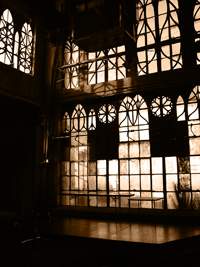 Yesterday afternoon, I was amused to receive a press release in my inbox regarding a local actor, Michael Rice (pictured, left). Rice, who is best known to many people in the Bay Area theatre community for his now-defunct “Cool As Hell Theatre Podcast” which the San Francisco NPR station KQED ran for a while, is passionate about self-promotion. This time, however, he might have gone a little too far.
Yesterday afternoon, I was amused to receive a press release in my inbox regarding a local actor, Michael Rice (pictured, left). Rice, who is best known to many people in the Bay Area theatre community for his now-defunct “Cool As Hell Theatre Podcast” which the San Francisco NPR station KQED ran for a while, is passionate about self-promotion. This time, however, he might have gone a little too far.
Rice is promising a “Money Back Guarantee” refund out of his own pocket to anyone who feels that his performance was sub par. The refund will be from Rice himself and not involve the producing theatre, the press release explains.
The actor has just closed a run as Trigorin in the Shakespeare’s Associates production of Chekhov’s The Seagull in Livermore, CA. He was previously seen in William A. Parker’s Waitin’ 2 End Hell at the Lorraine Hansberry Theatre in San Francisco. What’s not clear is whether the money back guarantee stands for a particular show he’s currently or soon to perform in, or whether it’s a general standard he plans to maintain for a while or his entire career.
“I create, sculpt, and deliver signature character pieces for the stage that are entertaining, bold, and believable,” states Rice. “If a patron comes to a show and does not believe I was entertaining, bold, and believable, I will refund their money,” he says.
Rice might be miffed to hear that he isn’t the first theatre person to have come up with the refund idea. Over in Chicago, The Chicago Tribune’s theatre critic, Chis Jones, published a story yesterday about the Collaboraction production of Migdalia Cruz’s El Grito del Bronx at the Goodman Theatre. At the end of the opening night performance, Jones reports that cast member Eddie Torres went on stage and told the audience that “anyone who didn’t feel like they had enjoyed the evening’s show should now make their way to a table in the lobby, where they could pick up a refund for what they’d spent on their tickets.”
Jones goes on to argue: “I hope the money-back guarantee dies a quick death, never to return. It’s not that I’m opposed to money-back guarantees in general–I recently took Home Depot up on a similar offer. But a piece of art is not a light fixture. And I think that such a speech is beneath the dignity of a fine artist like Torres. It’s a bit like watching an actor leap down from the stage and start clearing tables. Those in the audience know about economic realities, but it still makes us uncomfortable. We don’t like to see those who bare their souls for an audience’s edification and enjoyment have to stoop to such things.”
I share Jones’ indignation at the refund policy (to which nine audience members at The Goodman actually responded during the course of the run.) The money-back-guarantee schtick is cheap and gimmicky. No two ways about it. Theatre-makers who think that it will do something positive for audiences or their careers need to think again. Telling audiences they can have a refund shows either incredible hubris or a complete lack of confidence in one’s abilities as an artist.
Art is a commodity to a degree. But it doesn’t function in the same way as a light fixture in the marketplace. If a lightbulb doesn’t turn on or off, or if it’s cracked or broken, there’s clearly something wrong with it. It’s a black and white situation. But art can, generally-speaking, only be judged subjectively. Many great artists throughout history have seen their work boo’d by the public. If people like J S Bach or Oscar Wilde had operated under a money-back-guarantee, their lives would have been even more miserable.









